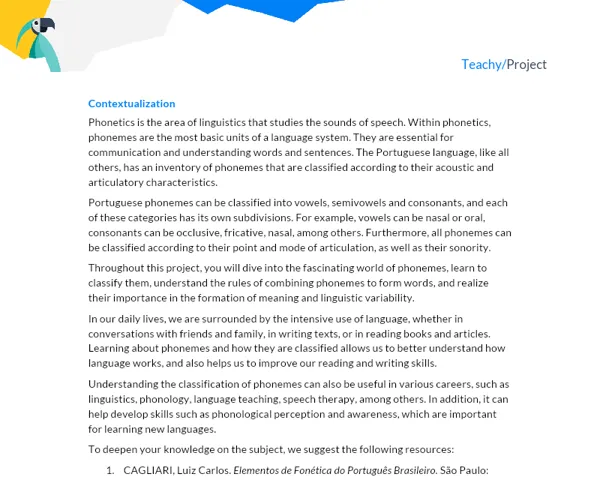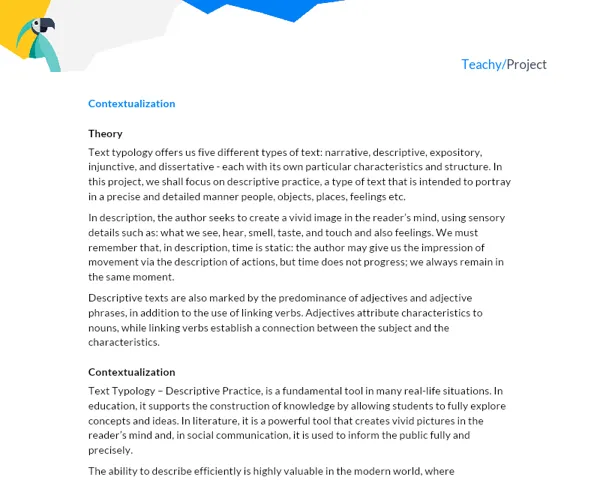Contextualization
Theory
Text typology offers us five different types of text: narrative, descriptive, expository, injunctive, and dissertative - each with its own particular characteristics and structure. In this project, we shall focus on descriptive practice, a type of text that is intended to portray in a precise and detailed manner people, objects, places, feelings etc.
In description, the author seeks to create a vivid image in the reader’s mind, using sensory details such as: what we see, hear, smell, taste, and touch and also feelings. We must remember that, in description, time is static: the author may give us the impression of movement via the description of actions, but time does not progress; we always remain in the same moment.
Descriptive texts are also marked by the predominance of adjectives and adjective phrases, in addition to the use of linking verbs. Adjectives attribute characteristics to nouns, while linking verbs establish a connection between the subject and the characteristics.
Contextualization
Text Typology – Descriptive Practice, is a fundamental tool in many real-life situations. In education, it supports the construction of knowledge by allowing students to fully explore concepts and ideas. In literature, it is a powerful tool that creates vivid pictures in the reader’s mind and, in social communication, it is used to inform the public fully and precisely.
The ability to describe efficiently is highly valuable in the modern world, where information must be transmitted rapidly and with maximum efficacy. As students learn to produce descriptive texts, they also develop the capacity for observation, an attention to detail, and an ability to organize and present thoughts in a coherent manner.
To better explore this subject, you may consult the following resources:
- The five types of texts - Mundo Educação
- What is a descriptive text? - Toda Matéria
- Text Typology - UOL Educação
Practical Activity
Activity Title: Painting with Words
Project Goal
The main objective is to develop the ability to describe objects, scenes, people or situations with precision and in detail, using all the tools of descriptive practice. It also encourages teamwork, effective communication time management and creativity.
Detailed Project Description
Students will be placed in groups of 3 to 5 individuals. Each group is responsible for developing and presenting a vivid portrait of an object, a person, a scene or a specific situation. They may use paraphrases and quotes as necessary. The aim is to use their words to “paint a picture” that will awaken readers’ senses.
Groups will have one week to work on this activity that is estimated to require 2–4 hours of work for each participant. Students should meet regularly (either face-to-face or virtually) to discuss, choose the focus of their description, research, share information, draw up an outline, edit and finalize the work.
Materials Required
- Pen/pencils and paper for taking notes
- A computer with an internet connection for research
- Other forms of media like videos, books and magazines for references
Step-by-step
- Form groups: Each team will be comprised of between 3-5 students.
- Choosing what to describe: Each group selects an object, person, setting or situation to depict.
- Research: Students must research the object of their description and note down any information that could prove useful for the task.
- Discussion: Students discuss together which details to use and how these will be organized for the text.
- Writing the descriptive text: Each student will write one part of the text, which will be reviewed and edited by the whole group.
- Editing: Each group member collaborates on editing and improving the final draft of the text.
- Final Presentation: The group will present the final version of their text to the rest of the class; each group member should contribute to the presentation.
Project Delivery
After completing the activity, each team should write a report containing the following:
-
Introduction: This should clearly explain the project theme, its objectives, and the importance of the text typology, and the practice of description. It should also provide a brief description of the focus of their chosen item.
-
Development: Here the team should describe the theory of descriptive texts and the methodology they adopted to produce their final version (how they made their choice and what research they did; how they worked in a team; the steps they undertook in editing and revision). The final version should be included in this section.
-
Conclusion: Here the students should summarize the key points and state what they learnt during the process, as well as any conclusions they have reached from this experience.
-
Bibliography: This should include all sources consulted during the project, such as books, websites and videos.
Each group should deliver a comprehensive report and make an oral presentation of the final version of the descriptive text to the class.



